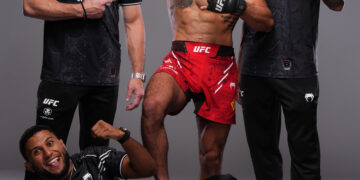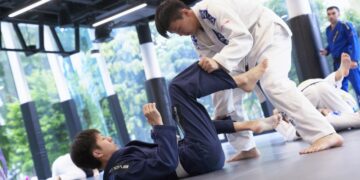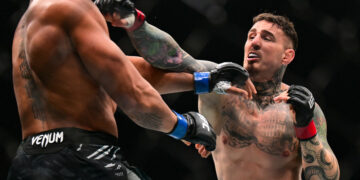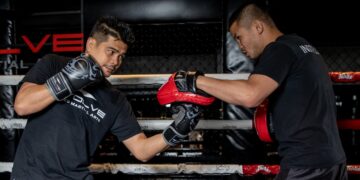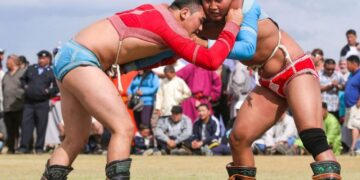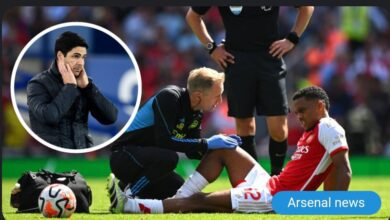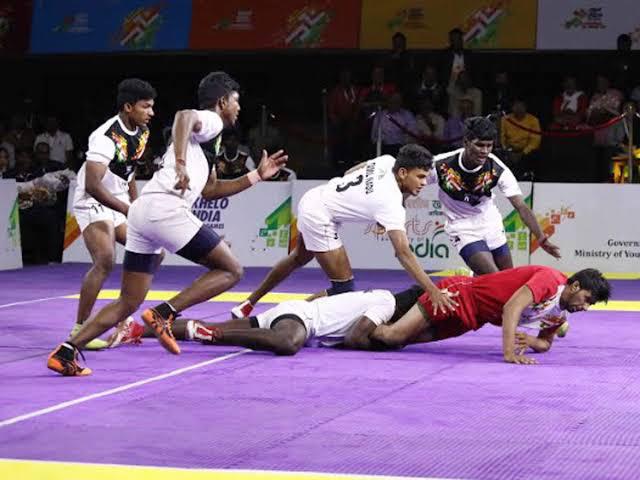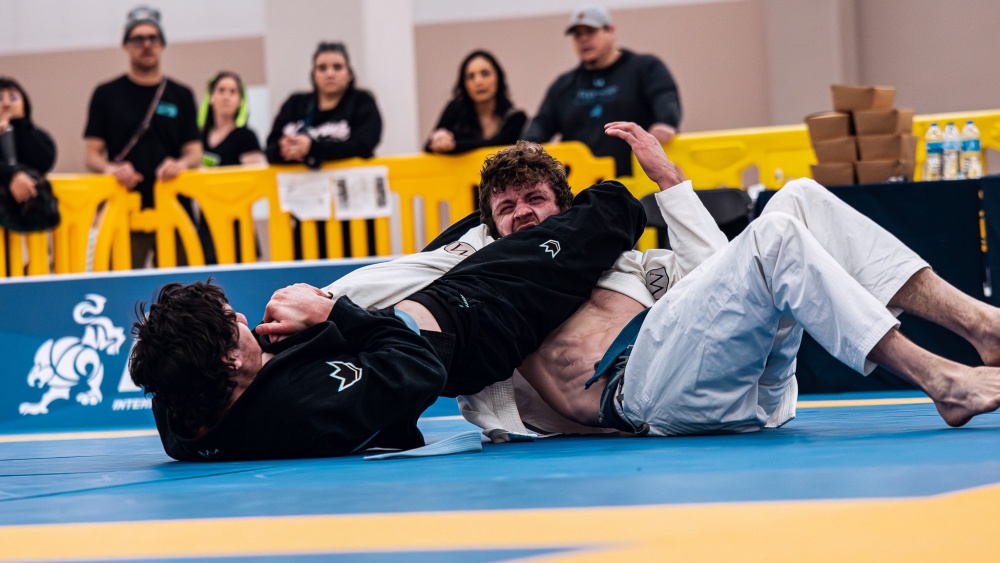
Your neck is often your unsung hero in grappling-based martial arts like Brazilian Jiu-Jitsu and Submission Grappling. It helps you perform techniques like the “bridge and roll,” and it’s your first line of defense against chokes. Building a strong neck doesn’t just protect you against chokes and cranks when grappling; it improves other aspects of your grappling game.
Understanding The Importance Of Neck Strength In Grappling
Let’s explore why neck strength is vital in grappling-based combat sports, how it protects you, and exercises that help to build an iron neck that can take on anything from collar ties to rear-naked chokes.
When you grapple, your neck is under constant stress, so its durability impacts how well you perform on the mats. Some of the reasons why neck strength is so vital in grappling arts include:
1) Improves Defense Against Chokes
Let’s make this clear before we go any further – having a strong neck doesn’t make you immune to chokes. However, a strong neck can buy you a few precious seconds to escape. The muscles around your neck create resistance, making it harder to lock in chokes.
2) Maintaining Posture
Posture plays an essential role in grappling-based martial arts. For example, you must break an opponent’s posture by pulling toward you in the bottom guard position to lock in submissions like triangle chokes. There’s no way around this reality.
A strong neck makes it harder for opponents to break your posture, protecting you against many popular submissions used in grappling arts. A strong neck also makes it easier to posture up and land strikes from top positions in sports like mixed martial arts (MMA).
3) Increases Durability
Grappling takes its toll on your body, particularly your neck. Strengthening the muscles around your neck protects you from the impact created by takedowns, scrambles, and neck cranks.
Breaking Down The Muscles In Your Neck
Your neck isn’t made up of a single muscle; it’s a complex system made up of:
- Sternocleidomastoids: These muscles run along the sides of your neck, allowing for rotation and flexion.
- Trapezius: This massive muscle covers the back of your neck, stabilizing your neck as you grapple.
- Deep Cervical Flexors: These smaller muscles in front of your neck control head movements and support posture.
You must target all three muscles to build an iron neck that’s difficult to lock up chokes on.
Some exercises you can target these muscles with include:
1) Neck Bridges
Neck bridges are a classic exercise among grapplers. These movements strengthen your entire neck, particularly the muscles in the back.
To perform neck bridges:
- Lay on the ground with your back and feet flat on the floor.
- Push your feet on the ground to lift your hips off it, transferring your weight to your head and neck. Keep your hands around your waist so your head carries most of your weight.
- Hold the position for a second before returning to the starting position to complete a rep.
Pro Tip: Don’t worry about pumping out your reps quickly when performing neck bridges. Instead, focus on controlled movement so you don’t overextend your neck. Start with three sets of as many reps as you can pump out, and gradually increase your reps as your neck gets stronger.
2) Resistance Band Neck Flexion
This exercise targets muscles in the front of your neck. You’ll need a resistance band and something sturdy to anchor on it.
Here are the steps:
- Attach the resistance band to a steady anchor.
- Wrap the band around your head and step back from your anchor point to create tension in the band.
- Slowly nod your head forward and return to the starting position to complete a rep.
Pro tip: Start with a light resistance band and increase the resistance once you can perform more than 15 reps.
3) Side Neck Raises
The side neck raises focus on the sternocleidomastoids, increasing your ability to resist cranks and lateral pressure.
Here’s how you perform neck raises:
- Lie on your side with your head hanging off a bench.
- Slowly lift your head toward your shoulders before lowering it back down. Perform 12 to 15 reps before switching to your other side.
- Keep your motion smooth while performing neck raises. Start with your body weight and gradually add resistance like a dumbbell or plate using a neck harness.
Advanced Neck Training Exercises
Once you’re comfortable with the abovementioned exercises, it’s time to move on to more challenging ones. These include:
1) Using Weighted Neck Harness
Using a weighted harness when performing neck exercises allows you to progressively overload your neck muscles, making them bigger and stronger. Strap on a harness and perform neck exercises that involve flexion, extension, and lateral movements.
Pro tip: A neck harness is an excellent investment for serious grapplers. Start light and gradually increase the weights you use to avoid straining your neck.
2) Partner Drills
Many training drills used in grappling-based martial arts also help strengthen your neck, so ensure you spend sufficient time performing positional drills. For example, you can get into your training partner‘s guard and have them try to break your posture down while you work to keep your torso upright.
Communication is key when performing such drills to ensure your training partners use an ideal amount of resistance.
3) Neck Mobility Exercises
Activities like Yoga teach you poses like the cat-cow stretch and neck rolls to improve flexibility in your neck and reduce stiffness.
Incorporate these stretches into your cooldown routine to keep your neck limber and healthy.
Why Neck Strength Pays Off
Building a strong neck isn’t just about improving your ability to survive chokes; it’s about thriving in all aspects of grappling. A strong neck will make you more stable when you roll, more challenging to control, and better equipped to resist submissions.
Put Your Neck To The Test
Neck strength isn’t developed overnight, but with consistent effort, your hard work performing neck exercises will make a noticeable difference on the mat. Add some of the exercises discussed above to see how much tougher you become as a grappler as you build up the muscles in your neck.
You may also like:
Here Are 6 High-Percentage Gi Chokes From The Technical Mount
The Muay Thai clinch is one of the most used techniques in striking and can also be used in grappling scenarios like Brazilian Jiu-Jitsu. Like the collar tie in grappling, the Muay Thai clinch can…
Fabricio Andrey is one of the most exciting Brazilian Jiu-Jitsu grapplers today. The signing of the young Brazilian grappling star paves the way for him to compete on the global stage of ONE Championship against…
The technical mount is one of the most versatile and dominant positions in Brazilian Jiu-Jitsu. From this position, you have control over your opponent’s movement while remaining highly mobile, making it ideal for setting up…
BJJ is a martial art that values both practicality and creativity. While foundational techniques form the core of a solid game, flashy moves can set you apart on the mats. These eye-catching techniques aren’t just…
Recently, BJJ has had its fair share of rising talents showcased in the grappling world. As the sport becomes more prevalent, it also calls for the attention of the younger generation, increasing the number of…
Martial arts are ever-evolving. Thought-provoking ideas, technique development, and the introduction of new rule sets keep them from growing. With Brazilian Jiu-Jitsu being one of the fastest-growing martial arts today, the idea of adding striking…
Figuring out if your workouts should consist mainly of hypertrophy or strength exercises comes down to your fitness goals. Are you there to get bigger or stronger? Hypertrophy training is what you need to build…
You’re in the heat of battle during a mixed martial arts (MMA) contest. Your opponent throws hard strikes at you with without caution, giving you plenty of opportunities to land precise counters. But then you…
If you’re new to martial arts in Singapore, you’re probably kicking and boxing almost daily. Why? Because the adrenaline high of sports is very motivating. Endorphins course through your body when you work out, giving…
Balancing a full-time job with your martial arts training sometimes feels like juggling flaming swords while walking a tightrope. However, there are innovative strategies that you can use to balance your training with your job…
A good recovery routine ensures your body is ready for your next martial arts training session. It also lets your body get the most out of all the hard work you put in at the…
Low kicks play an interesting role in Muay Thai. They are powerful, effective, and landing several of them in a round can chip away at both a fighter’s speed and confidence. However, they rarely have…





